By Paul Wiseman
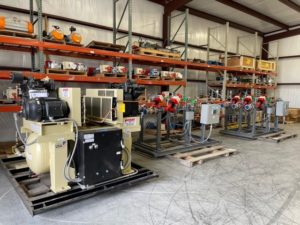 It’s almost like you can find the words “innovation” and “automation” on the same page of the dictionary today, despite their obvious alphabetical distance. In this economy the efficiency and data insights offered by automation lets the systems pay for themselves quickly in both reduced overhead and increased production.
It’s almost like you can find the words “innovation” and “automation” on the same page of the dictionary today, despite their obvious alphabetical distance. In this economy the efficiency and data insights offered by automation lets the systems pay for themselves quickly in both reduced overhead and increased production.
One company that’s forging ahead is, well, one company that used to be two separate ones. In March of 2022 Eagle Automation had the opportunity to “join forces” with VanZandt Controls. Larry Richards, CEO of the latter, was retiring, and Eagle was given the opportunity to make that move, said Eagle CEO Don Magness. The new company is known as VanZandt Eagle.
Before the joining of forces, Eagle had been primarily an automation and instrumentation provider, connecting with third-party equipment, while VanZandt had been a provider of valve automation. So the joining together gave the new company more options as well as more locations than either had previously had.
“It really let us move up a level in the industry,” Magness said. “Together we’re a lifecycle provider of automation products, solutions, and services.
“Now we’re 13 locations and 200 employees, which is massive, across four states.” The new company is “more than a box mover,” meaning they can design the automation solution, as well as provide, install, and service the products, and plus deliver a number of other services.
Magness noted that many E&Ps, even larger ones who at one time hosted their own automation/instrumentation groups, are beginning to farm those services out. “The problem is,” he observed, “all those folks [who managed the systems] are retiring. So they’re looking for two things: they’re looking for somebody that can come in and not just sell them product, but deliver outcomes; and for the ones that used to do it themselves, it’s becoming harder to do.” Faster advances, more complex systems, and much greater data input has made automation and data systems a world for specialists as never before.
Forces of Change
The combination of technology and ESG (environment, societal, and governance) issues has pushed a significant change in the design of valve operation, for example. “In the past, operators could put a pneumatic valve on a well and operate that valve off of the actual methane gas” from the well. “The EPA has now said that you can’t do that anymore” because under that system the methane would escape into the atmosphere depending on whether it opened or closed the valve.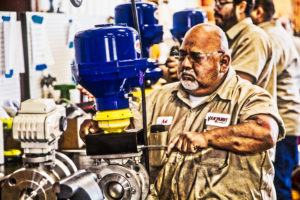
With the EPA ruling there are two options. Operators can install a compressor to operate all the existing valves by compressed air, or they can replace them all with electric versions. Both involve a costly undertaking and can be farmed out to a company like VanZandt Eagle.
Fortunately those kinds of costs are offset by the extensive advantages provided by automation systems. Using automation to manage gas lift compressors is one way. Instead of using multiple skids of compressors that are manually adjusted by technicians, an automation system, using a system of valves and sensors, can use a single compressor to efficiently work several wells. Real time data allows the automation system to adjust flow rates as needed, keeping everything operating at top efficiency while reducing down time—improving production while reducing costs in equipment and payroll.
Artificial Intelligence (AI) can collect and manage data to the point that it informs the operator of significant changes predicting the need for maintenance or repair before a crash actually happens—or at least as soon as one does. Even in the event of a failure AI provides pertinent data leading up to the issue, which can inform future decisions as it “learns” the operation. It can filter data to where it zeroes in on what the customer needs to know.
A unique service VanZandt Eagle provides is circuit board repair—something Magness says is even more important with supply chain issues affecting electronic replacement parts. The facility, located in Farmington, N.M., can repair about 40 types of boards. Repairing instead of replacing also keeps boards out of the landfill, he pointed out.
Blending Efficiency with Security
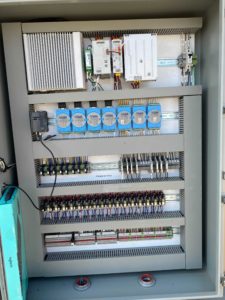 Albert Rooyakkers, founder and CEO of Bedrock Automation, sees the need for automation systems to be both highly efficient and extremely secure, a combination that is not always available.
Albert Rooyakkers, founder and CEO of Bedrock Automation, sees the need for automation systems to be both highly efficient and extremely secure, a combination that is not always available.
“Cyber security is important only once it’s important relative to the user,” he observed. In other words, only after it’s too late in many cases. The only way cyber security works, in his view, is that “It has to be invisible and it has to be free.” Most security providers would agree with the “invisible” part. “Free” is where Bedrock differs from pure security companies. Bedrock embeds security measures into their hardware. The realization in 2012 that remote hardware was one of the most insecure parts of a network is what started Rooyakkers on the road to founding Bedrock Automation.
He noted that “invisible and free” are how bank apps on a smartphone operate. Paying through a phone app for, say, coffee on an unsecured network is accomplished because “in the background is this very complex certificate authority, public-private key exchange, TLS-encrypted tunnel, all these e-commerce infrastructure tools and standards that go to work for you—and you don’t pay more for it.” There’s not a need to choose between a free, non-secure app versus a paid, secure version. “Security just happens and you don’t have to pay for it.”
This type of security is not generally available in the OT (operational technology) field, he said.
For Bedrock, however, “We built this product, an automation system, that is secure by design, secure by default, that’s built in versus bolted on,” he said. “Security just happens.”
This removes most of the complications inherent in other systems, he said, allowing them to make the most of the information and efficiencies of the automation system itself.
On that score, Rooyakkers said, “Efficiency is connectivity. Connectivity means you’ve got to take advantage of the public network.” Remote access only works through a network, and virtually no one has the time or resources to create their own private network. This exposure to public networks, he feels, is why cyber security is vital.
Before long, Rooyakkers sees satellite communications as a bypass for public networks, with the former offering an improvement in accessibility because there’s no such thing as a location that’s too remote for satellites to reach.
As an example of what remote systems can do, Rooyakkers told of a client who provides portable remote water systems for frac jobs. His equipment centers around large water pumps and flexible pipes. Continuous operation is vital to those customers because, as Rooyakkers pointed out, “If you’ve got no water, you’re not frac’ing. How do you manage these remote water systems that have hundreds of miles of flexible pipe.” If the pipe is breached in a remote location, it could cause significant problems if not quickly detected, located, and repaired. 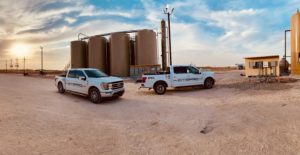
The Bedrock system withstands extreme temperatures and rough roads, Rooyakkers said. With motor-mounted sensors, “He gets motor status, motor RPM, and he’s running motor diagnostics,” data that goes into the Cloud. “He has remote, real-time access to all these systems from wherever he is in the world.”
Therefore, “He always knows what’s going on with his engines, he knows what’s going on with his systems, he is able to run the kind math that he needs to do—getting leak detection by just regulating fluctuations in the differential pressure and flow,” said Rooyakkers. Quickly locating remote leaks saves thousands of gallons of water and prevents long downtimes at the frac job.
Expanding the Business
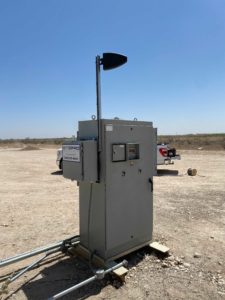 When Lubbock-based SitePro was founded in 2012, they concentrated on automation for water handling. The growing requirements for handling fresh water for frac’ing and produced water for disposal or recycling was expanding the need for logistics and control. So that by itself was a great niche for the company.
When Lubbock-based SitePro was founded in 2012, they concentrated on automation for water handling. The growing requirements for handling fresh water for frac’ing and produced water for disposal or recycling was expanding the need for logistics and control. So that by itself was a great niche for the company.
About two years ago, said company Chairman of the Board and Co-CEO (with Aaron Phillips) David Bateman, someone suggested their water automation systems would translate well to municipal water utilities, and other industries. Resisting the idea at first, Bateman and other company leaders were convinced by ensuing events that broadening their footprint would indeed be smart.
It was smart indeed. “We’ve been quite successful with it—quickly,” Bateman said. In addition to water utilities, they’ve added large scale agricultural irrigation for high value crops as well.
“I tell everyone, you can’t manage what you can’t measure and you can’t measure what you can’t see,” he said. And that is true no matter the industry. “At SitePro, we help people with fluid-based systems.” These include automation and real-time data capture for decision making.
Bucking the Trend
With costs on so many goods and services skyrocketing, SitePro has continued to innovate and redesign their hardware to do more with less—which has cut costs dramatically. “We’ve been able to really draw the hardware costs down significantly.”
This brings up the supply chain question, as to whether they’re staying ahead on equipment and parts. Bateman stated that the supply department has stayed ahead of the curve overall other than special order equipment. If there are supply chain delays, they’re mostly with clients experiencing delays in project progress, waiting for drill pipe, tanks, or other equipment. 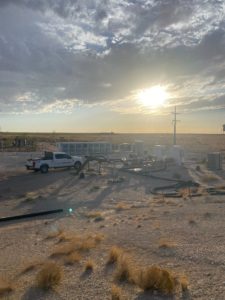
Installing automation has become an easier sell since 2012. In the early days, Bateman recalled, automation systems were rarely included in any new capital projects because at that time automation was not seen as economical. “Nowadays, automation is on just about every project that we see.” And the requirements have changed. No longer just looking for readings or some remote control, “Now the things they’re asking for are systems integration, advanced analytics, personnel tracking, AI, the next generation of use, so to speak.”
Automation itself has advanced greatly as well. Vendors like SitePro can integrate with existing automation hardware to simplify everything, putting data “all into one dashboard.”
Security is also vital to SitePro. “We’ve built through a partnership with Microsoft and Redis Labs,” he said. That partnership allows data to be protected similarly to the way debit and credit card information is secured during transactions.
Innovation is clearly survival for every automation provider, and those who are succeeding are doing just that.
______________________________________________________________________________________________________
Paul Wiseman is a freelance writer in the oil and gas sector.










